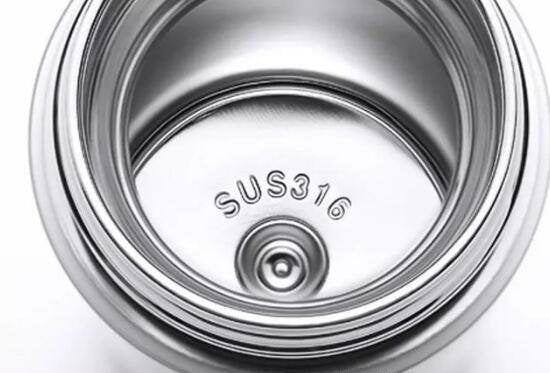
The difference between 304 stainless steel and 316 stainless steel
Compartir
Stainless steel has penetrated into every aspect of people's lives. 304 stainless steel is also well-known as food-grade stainless steel. Now businesses often promote 316 stainless steel. What are the differences between them?
Stainless steel is a type of alloy steel
The full name of "stainless steel" we usually talk about is "stainless acid-resistant steel". If you want to make steel rust-free, it is actually very simple. You only need to add some metal impurities to make alloy steel (such as adding chromium). But the fact that it doesn't rust only means that it won't be corroded by the air, and its ability is still too poor. So we also need it to be resistant to chemical corrosion, so "stainless acid-resistant steel" appeared. If you want to make stainless acid-resistant steel, you need to add many kinds of metals. Different metal formulas form different stainless steels.
304 and 316 are both austenitic stainless steels
Stainless steel is often divided according to its organizational state: martensitic steel, ferritic steel, austenitic steel, austenitic-ferritic (duplex) stainless steel and precipitation hardening stainless steel, etc. In addition, it can be divided according to its composition: chromium stainless steel, chromium-nickel stainless steel, chromium-manganese-nitrogen stainless steel, etc. Among them, austenitic stainless steel has the best comprehensive performance and is non-magnetic, so it is the most widely used in our daily life. Both 304 and 316 are austenitic stainless steel.
304 and 316
304 stainless steel has strong anti-corrosion capabilities and is classified as a "food grade" metal by the national standard - it will be no problem in normal contact with water, tea, coffee, milk, oil, salt, sauce, vinegar, etc. 316 stainless steel is a further upgrade on this basis (controlling the impurity ratio and adding molybdenum) to make it more corrosion-resistant. In addition to oil, salt, sauce, vinegar and tea, it can withstand all kinds of strong acids and alkalis. Not only that, 316 stainless steel has better adaptability to the environment. Too high or too low temperature will not affect the corrosion resistance of 316 stainless steel. However, the production cost of 316 is higher and the price is also higher.
Several common models
304: 18/8 stainless steel. Products such as: corrosion-resistant containers, tableware, furniture, railings, and medical equipment. The standard composition is 18% chromium plus 8% nickel. It is a non-magnetic stainless steel whose metallographic structure cannot be changed by heat treatment. The GB grade is 06Cr19Ni10.
304 L: Same characteristics as 304, low carbon so it is more corrosion-resistant and easier to heat treat, but has poor mechanical properties.
304 N: It has the same characteristics as 304. It is a nitrogen-containing stainless steel. Nitrogen is added to improve the strength of the steel.
316: After 304, it is the second most widely used steel type. It is mainly used in the food industry, watch jewelry, pharmaceutical industry and surgical equipment. The addition of molybdenum element gives it a special corrosion-resistant structure. Because it has better resistance to chloride corrosion than 304, it is also used as "marine steel". SS316 is usually used in nuclear fuel recovery devices.
316 L: Low carbon, so it is more corrosion-resistant and easy to heat treat. Products such as: chemical processing equipment, nuclear power generators, and refrigerant storage tanks.
Comprehensive consideration of cost performance
For food steel, 304 is sufficient and has almost no defects; using 316 in this regard is purely overkill, and the strength of 316 over 304 is not reflected at all. Therefore, when consumers choose products, they can make a comprehensive judgment based on their needs and cost-effectiveness and choose the appropriate product.
Stainless steel is a type of alloy steel
The full name of "stainless steel" we usually talk about is "stainless acid-resistant steel". If you want to make steel rust-free, it is actually very simple. You only need to add some metal impurities to make alloy steel (such as adding chromium). But the fact that it doesn't rust only means that it won't be corroded by the air, and its ability is still too poor. So we also need it to be resistant to chemical corrosion, so "stainless acid-resistant steel" appeared. If you want to make stainless acid-resistant steel, you need to add many kinds of metals. Different metal formulas form different stainless steels.
304 and 316 are both austenitic stainless steels
Stainless steel is often divided according to its organizational state: martensitic steel, ferritic steel, austenitic steel, austenitic-ferritic (duplex) stainless steel and precipitation hardening stainless steel, etc. In addition, it can be divided according to its composition: chromium stainless steel, chromium-nickel stainless steel, chromium-manganese-nitrogen stainless steel, etc. Among them, austenitic stainless steel has the best comprehensive performance and is non-magnetic, so it is the most widely used in our daily life. Both 304 and 316 are austenitic stainless steel.
304 and 316
304 stainless steel has strong anti-corrosion capabilities and is classified as a "food grade" metal by the national standard - it will be no problem in normal contact with water, tea, coffee, milk, oil, salt, sauce, vinegar, etc. 316 stainless steel is a further upgrade on this basis (controlling the impurity ratio and adding molybdenum) to make it more corrosion-resistant. In addition to oil, salt, sauce, vinegar and tea, it can withstand all kinds of strong acids and alkalis. Not only that, 316 stainless steel has better adaptability to the environment. Too high or too low temperature will not affect the corrosion resistance of 316 stainless steel. However, the production cost of 316 is higher and the price is also higher.
Several common models
304: 18/8 stainless steel. Products such as: corrosion-resistant containers, tableware, furniture, railings, and medical equipment. The standard composition is 18% chromium plus 8% nickel. It is a non-magnetic stainless steel whose metallographic structure cannot be changed by heat treatment. The GB grade is 06Cr19Ni10.
304 L: Same characteristics as 304, low carbon so it is more corrosion-resistant and easier to heat treat, but has poor mechanical properties.
304 N: It has the same characteristics as 304. It is a nitrogen-containing stainless steel. Nitrogen is added to improve the strength of the steel.
316: After 304, it is the second most widely used steel type. It is mainly used in the food industry, watch jewelry, pharmaceutical industry and surgical equipment. The addition of molybdenum element gives it a special corrosion-resistant structure. Because it has better resistance to chloride corrosion than 304, it is also used as "marine steel". SS316 is usually used in nuclear fuel recovery devices.
316 L: Low carbon, so it is more corrosion-resistant and easy to heat treat. Products such as: chemical processing equipment, nuclear power generators, and refrigerant storage tanks.
Comprehensive consideration of cost performance
For food steel, 304 is sufficient and has almost no defects; using 316 in this regard is purely overkill, and the strength of 316 over 304 is not reflected at all. Therefore, when consumers choose products, they can make a comprehensive judgment based on their needs and cost-effectiveness and choose the appropriate product.
